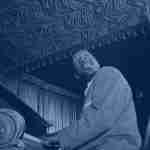A reader recently asked: “I was wondering about how to play over altered dominant chords. What are some strategies for playing over Dominant 7 #9 chords, specifically.” This question comes up frequently for many improvisers. It seems like everyone has a “fail safe” scale or lick that they use exclusively every time they see an altered dominant chord. With all this conflicting information flying around, trying to understand what actually works can be especially confusing.
Whether it is a V7#9, a V7#11, or a V7 Alt., you ultimately need to study the ins-and-outs of these chords in order to develop your own approach.
Traditionally, the V7#9 chord or altered dominant chord occurs in a minor ii-V progression. Instead of the ii-V7 of a major progression, a minor ii-V contains a half-diminished ii chord and an altered V7 chord (b9, #9, b13, or #11 depending on the voicing). For example, look at a minor ii-V in C minor:
Improvisers, however, have been altering V7 chords in all progressions, major and minor alike, for quite some time now. Therefore, any dominant chord that you come across, whether it is part of a ii-V or standing alone, is pretty much fair game for alteration. The first step to navigating this chord is to familiarize yourself with it’s unique character.
Be able to identify the sound
The V7#9 chord is a very versatile sound, meaning that you can take one of many harmonic approaches to play over it. In order to fully utilize the harmonic possibilities available though, you must first be able to aurally recognize the unique sound of each “altered” note.
For starters, go to the piano and play a V7 chord in root position. On top of that voicing play the #9 of the chord. Sing that note, internalize it’s character, and hear how it relates to the other notes of the chord. Now that it’s in your ear, resolve that V7 to the I chord and take note of how the dissonance of the #9 can be resolved at the arrival of the I chord.
After you’ve got that down, repeat the process with the other altered notes of the V7: the b9, the b13, and the #11, until you can hear the unique sound of each altered note and it’s logical resolution.
Once this sound is aurally ingrained, go to the records and listen for examples of the different uses of V7#9 chords. One example is from the opening of Coltrane’s composition Blue Train, especially listen to the piano voicing:
Another example of a V7#9 chord is from the horn opening to the Blood, Sweat and Tears tune Spinning Wheel:
The altered scale
If you ask most educators or look in a number of jazz theory books, they will tell you to play an “altered scale” over this chord. This scale can also be referred to as the diminished whole-tone scale (in that it begins with the half-whole diminished scale and ends with the whole-tone scale):
Another simple way to think about this scale is a melodic minor scale starting on the seventh note. In the case of a G7#9 chord, an Ab melodic minor scale starting on G:
Ab melodic minor ——————————-> G7 Altered Scale (b9, #9, #11, b13)

Coming from the Ab melodic minor scale, you can also utilize different sounds inherent within this scale. For instance, you can think of a Ab minor-major 7 chord over the G7#9, in essence thinking Ab- over G7#9:
In the same fashion, you can play a B Major7 #5 sound over the G7#9:
Don’t stop there
While this scale contains all of the altered notes (b9, #9, #11, and b13), keep in mind that it is just one theoretical option that works over a V7#9 chord. The goal is to use lines that you’ve learned from records as a basis for improvisation, not just scales.
When you see a chord symbol or hear a progression, you don’t want to just think of a scale from root to root in your head, you need to have numerous options. For instance, when you encounter a C Major 7 chord, you aren’t only thinking of a C major scale from C to C (or at least you shouldn’t be!), you’re using your ears and drawing from language that you’ve developed over that sound.
The same is true for this chord V7#9, don’t think of only the altered scale, have multiple harmonic approaches and lines at your disposal.
Learn some language
So now that you’ve got the sound of the chord in your ears, it’s time to go to the records and study how your heroes are playing over altered dominant sounds. Because V7 chords are in nearly every standard you’ll come across in this music, there are endless opportunities to transcribe some language to incorporate into your playing.
To begin, why not study how great players alter dominant chords over the blues or how they utilize V7#9 chords on the bridge to rhythm changes.
One example of a standard way to play this sound, using language instead of a straight scale, is shown below. This line contains the altered notes of the A7 chord (b9, #9, and b13), but uses them is a more melodic fashion than simply playing the altered scale up and down:
For another idea of this concept, check out this clip of Freddie Hubbard playing over his blues Birdlike, with McCoy Tyner. Notice how Freddie begins his solo (4:54) creatively using material from the altered scale:
Find your own approach
Your goal as an improviser is to develop your own approach to these chords based upon what you’ve learned from listening and transcribing this music. See how many harmonic approaches or varieties you can come up with to navigate this V7#9 sound. Some different ideas could include:
- A Triadic Approach
- Tri-Tone Substitutions
- Diminished Patterns
- Whole-Tone Movement
- Pentatonic Lines
What works for one V7 chord…
This many seem like a lot of material to get together, but remember that everything you would play over a V7#9 chord, you can also use over any normal dominant 7 chord. A V7 chord is the spot in a chord progression where the harmonic tension is going to be resolved at the I chord, therefore, the degree of dissonance or harmonic tension that is included is entirely up to you.
Whether you want to highlight the #11, the b9, or even the #9 and b13 it will work with the harmony as long as you use the material musically and resolve the tension appropriately. The key is to keep checking out as many records and players as you can. The path to developing your own sound lies with seeing how many unique ideas and new approaches you can come up with.
















